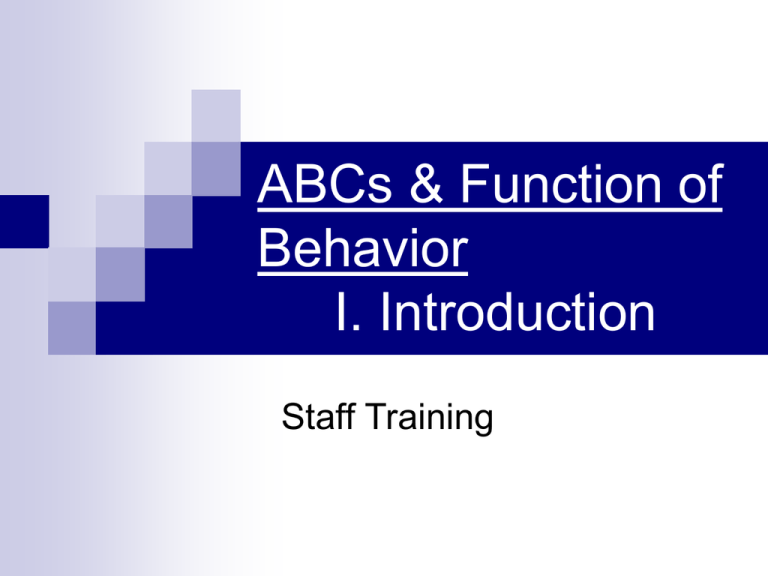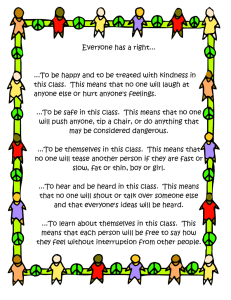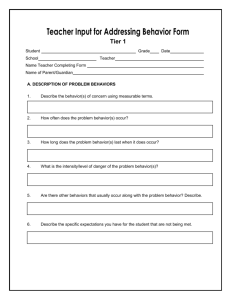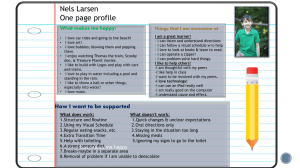ABCs & Function of Behavior I. Introduction Staff Training
advertisement

ABCs & Function of Behavior I. Introduction Staff Training ABC Training series This is the first of a series of 5 trainings on understanding student behavior & linking it to intervention This is part of our schools ongoing development & implementation of PBS systems in our district The content of this training will be directly linked to our Pre-referral/Intervention team process for supporting students who are at-risk for problem behavior CONTINUUM OF SCHOOL-WIDE POSITIVE BEHAVIOR SUPPORT Tertiary Prevention: FBABSP for Students with High-Risk Behavior ~5% ~15% Primary Prevention: School/ClassroomWide Systems for All Students, Staff, & Settings ~80% of Students Secondary Prevention: Specialized Group Systems for Students with At-Risk Behavior Why Do People Behave? Modeling? Accident? Instinct? Condition?? Why Do People Continue Behaving? IT WORKS! Understanding Chronic Misbehavior If a student repeatedly engages in a problem behavior, he/she is most likely doing it for a reason, because it is paying off for the student The behavior is Functional or serves a purpose Behavior is a form of communication, unfortunately some students learn that Problem Behavior is the best way for them to get their needs met Understanding Chronic Misbehavior Recognize that recurring misbehavior occurs for a reason, and take this into account when determining how to respond to misbehavior. We can understand how to intervene most effectively with a student by identifying the function (or purpose) of their behavior Functions of Behavior Problem Behavior Escape/ Avoid Something Obtain/Get Something Stimulation/ Sensory Tangible/ Activity Social Adult Peer ERASE problem behavior Explain - What is the problem? Reason - What is he/she getting out of it or avoiding? (What is the Function/Pay off of the Behavior?) Appropriate - What do you want him/her to do instead? Support - How can you help this happen more often? Evaluate - How will you know if it works? ABC’s of Understanding Chronic Behavior Patterns What happens before (A or antecedent) the behavior occurs? What is the trigger? What is the behavior (B)? What happens after (C or outCome/ Consequence) the behavior occurs? What is the outCome? ABC Summary Statement Based on several observations Identifies predictable relationships between environmental variables and behavior (some routine) During When (some Antecedent condition occurs) student will (engage in a specific Behavior) because (a predictable outCome will occur) therefore the function of the behavior is to access /escape/avoid (something in the environment) (choose one) Summary Statement Based on several observations Identifies predictable relationships between environmental variables and behavior Science (some routine) or Social Studies During askedA tontecedent read out loud in class When (some condition occurs) student will Verbally refuses, disrespects teacher (engage in a specific Behavior) because his(ateacher callsout onCsomeone else predictable ome will occur) therefore the function of the behavior is to access /escape/avoid (something oral reading in the environment) (choose one) ABC & Learning: An example Learning & ABC What did the student learn? A Student is asked to do a math problem in front of the class B C Learning & ABC What did the student learn? A B Student is asked to do a math problem in front of the class Student tries to do the problem at the board, but struggles C Learning & ABC What did the student learn? A Student is asked to do a math problem in front of the class by Mr. Brown B C Student tries to Peers laugh at student do the problem at and one says aloud, the board, but “that one is so easy” struggles Bad OutCome for Student Student w/ Problem Behavior ABC Jimi has Learned that: When (A) asked to do a difficult math problem on the board in front of his class by his math teacher, if he (B)ehavior, tries his best and can’t do the problem The out(C)ome is: he gets made fun of by his peers, called stupid and laughed at Negative OutCome (Punisher) = DECREASE of Desired Behavior in that situation in the future Learning & ABC A Student is asked to do a math problem in front of the class B C Student tries to Peers laugh at student do the problem at and one says aloud, the board, but “that one is so easy” struggles Punishing Consequence NEXT DAY Student is asked What Student: to do a math -Hits peer problem in front happens -Calls teacher of the class name or today??? -Disrupts Teacher calls on someone else & sends student to office Student w/ Problem Behavior ABC Jimi has Learned through repeated experiences, that when (A) asked to do math problems (dbl digit multiplication or division) at his desk or on the board in front of his class, if he (B), calls the teacher names, refuses work or throws his paper on the ground, the out(C)ome is he gets sent to the back of the room and avoids the difficult math problem & embarrassment of failing in front of his peers. *Function = Problem Behavior helps Student AVOID task. What is the Pay Off? We need to understand behavior from the student perspective… What is the student gaining (or trying to get) from engaging in this behavior What is the most important thing that the student is gaining or avoiding by using this behavior Behavior is Functional, Not GOOD or BAD Functional = it pays off for the student in some way… so they do it again We may see the behavior as being “good” or “bad”, but the student does it because it is effective, it pays off for them Sample Summary Statement BRENDA HITS OTHER STUDENTS - WHY WOULD SHE DO THIS? Antecedents Behavior Consequences Susan calls Brenda a Brenda punches Susan on Susan stops laughing and “creep face” and laughs the arm walks away Summary Statement at her WHEN OTHER CALL ANTECEDENT HER NAMES OR , A group of studentsSTUDENTS at Brenda kicks several of TheTEASE studentsHER run away BRENDA BEHAVIOR THEM BECAUSE CONSEQUENCE THEY GO AWAY recess callHURTS Brenda fat them Brenda spells a word incorrectly during an oral review and the child behind her laughs Brenda is playing blocks with Ben. Ben takes a block from Brenda Brenda pulls the child’s hair Brenda is sent to the office Brenda hits Ben over the head with another block Ben puts the block down and runs away Practice Activity TRACY MAKES RUDE COMMENTS TO PEERS WHY WOULD SHE DO THIS? Antecedents Another girl sits down at table Behavior w/ a mean voice - “Who said you could eat at my table…” Consequences Peer gives negative look, but no response Peers giggling – girl DEVELOP A SUMMARY STATEMENT FOR TRACY ignores Negative look/ no response “I thought cows ate grass” Peers giggling at previous “don’t you know it’s rude to Girl gives negative look, WHEN ANTECEDENT , but comment read at the table?” says nothing BEHAVIOR BECAUSE CONSEQUENCE Negative look by girl, no response from peers “hello!”, throws bag in girls face Peers laugh girl calls Tracy ‘jackass’ Peers laugh Excuse me” throws food at girl Peers laugh loudly, girl laughs, staff intervenes “Man, I’m being punished for cruelty to animals” Peers laugh; Tracy escorted to office by staff Peers laugh loudly Practice Activity -- Answers TRACY MAKES RUDE COMMENTS TO PEERS WHY WOULD SHE DO THIS? Antecedents Behavior Consequences Another girl sits down at table w/ a mean voice - “Who said you could eat at my table…” Peer gives negative look, but no response Negative look/ no response “I thought cows ate grass” Peers giggling – girl ignores Summary Statement Peers giggling at previous “don’t PEERS you know&it’s rude to Girl givesARRIVES negative look, WHEN SITTING WITH COOL ANTECEDENT ‘UNCOOL’ PEER , but comment read atBECAUSE the table?” CONSEQUENCE nothing TRACY MAKES BEHAVIOR RUDE COMMENTS THE PEERSsays LAUGH Negative look by girl, no response from peers “hello!”, throws bag in girls face Peers laugh girl calls Tracy ‘jackass’ Peers laugh Excuse me” throws food at girl Peers laugh loudly, girl laughs, staff intervenes “Man, I’m being punished for cruelty to animals” Peers laugh; Tracy escorted to office by staff Peers laugh loudly *If you look at the ABC’s of a specific Behavior you will better understand the FUNCTION or PAY OFF of that behavior for the student. Stop and Think: What is the child really trying to communicate by his/her behavior? What does the teacher think is the consequence? vs. What the child sees as the real consequence?(gained or avoided what?) What can we do to decrease/change the behavior? How can we help? Task Over the next 2 weeks… Complete the provided worksheet to track 5 ABC sequences for a single student that is engaging in recurring problem behavior SELECT A STUDENT WHO HAS A CHRONIC BEHAVIOR, BUT IS NOT THE TOUGHEST OF THE TOUGH Turn worksheet in to your PBS Team Leader If you turn in your worksheet, you will be eligible for … <ID incentive here> At our next ABC training we will… Review your ABC activity & provide more practice with ABCs & Function of Behavior with video vignette




